Transforming clinical practice in maternal and newborn care – insights from LDI:REACH

In this blog, Dr Alison Wright, Clinical Advisor for FIGO LDI:REACH, reflects on her recent visit to programme facilities in India and Bangladesh. Through on-the-ground experiences, she highlights how frontline OBGYNs are identifying challenges, driving solutions and leading improvements in maternal and newborn care.
An innovative and pioneering programme
The LDI:REACH programme has truly been one of the highlights of my career. From the moment I heard about LDI:REACH at FIGO, I knew I wanted to be a part of it. Travelling around facilities in Bihar, Dhaka and Faridpur, with respected colleagues from India and Bangladesh, was such a privilege. It was deeply humbling to see them working with such cheer and dedication, often in very challenging circumstances.
As healthcare providers, we go into the field of obstetrics and gynaecology with the aim of delivering the best possible care to women. However, due to external pressures, limited resources and gaps in appropriate training, we sometimes find ourselves unable to do so – a reality that can be deeply distressing.
LDI:REACH is an innovative and pioneering programme built on a simple concept: asking frontline OBGYN clinicians what they need to provide the best possible care for women and their babies – while recognising and supporting them as leaders in driving those improvements forward.
Targeting proven clinical interventions
The programme focuses on six countries and targets four key clinical interventions: E-MOTIVE for postpartum haemorrhage (PPH), magnesium sulphate for pre-eclampsia and eclampsia, corticosteroids for preterm birth, and the management of anaemia during pregnancy. Each member society has identified these interventions as evidence-based practices that, when implemented effectively, significantly improve maternal and neonatal outcomes.
This led us to ask, “If these proven interventions can save lives, why aren't they consistently being used?”
To explore this, frontline OBGYNs were engaged to identify the barriers preventing implementation, as well as practical solutions to overcome them. The programme continuously tracks the effective coverage of each intervention at participating facilities. This enables teams to monitor the impact of barrier removal, assess improvements in care delivery and pinpoint where further efforts are needed.
Key insights: challenges, solutions and positive outcomes
In a healthcare landscape where many professionals feel disempowered and unsupported to deliver the high-quality care they strive for, the agency and advocacy granted to OBGYNs through this programme has proven to be deeply rewarding, both personally and professionally.
During visits to Bihar, Dhaka and Faridpur, one of the most gratifying experiences was witnessing the pride and satisfaction of OBGYN colleagues as they shared not only the specific barriers they had faced in implementing clinical interventions, but also the solutions they had developed to overcome them.
A shared challenge across India and Bangladesh was the lack of simulation training – a critical component for emergency preparedness. This gap was identified by the clinicians themselves, who impressively took the initiative to address it. During our visits, we observed highly effective and professional simulation drills for PPH, complete with 360-degree feedback from all participants, which included reflections on how patients experienced communication during the emergency.
Stories of impact
One story that stands out is of a dedicated doctor working single-handedly in a remote facility in Bangladesh. She identified a critical barrier to implementing the PPH guideline (E-MOTIVE): the absence of a fridge to store essential medications. By formally reporting this issue through the programme, the barrier was escalated to the head commissioner, who secured funding to resolve it. Her account of the experience was truly inspirational – she expressed genuine joy in having achieved this improvement for the women under her care, and we shared in that joy.
In another remote facility, an OBGYN recognised the lack of a clear escalation process for transferring patients with pre-eclampsia or PPH to a central facility. Once identified, the issue was promptly addressed. This not only improved the timeliness and quality of care for critically ill women, but also strengthened professional relationships between local and central teams – bringing broader benefits to the overall working environment.
Advancing maternal and reproductive health worldwide
The visits provided a valuable opportunity to collaborate with our member societies and empower frontline OBGYNs, furthering FIGO’s mission to advance women’s health and rights globally. This approach is not only inspiring but also proven to be effective in practice.
The principles behind this initiative are universally applicable. Imagine the transformative impact if we simply asked all frontline OBGYNs, “What do you need to improve care?” and then committed to supporting them to make it happen. I have no doubt that such an approach would lead to vastly improved services for women and their babies.
FIGO and its member societies are leading the way with this approach through LDI:REACH.